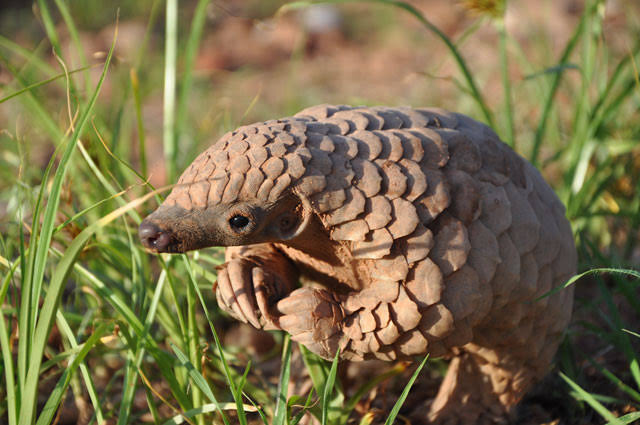If you’ve ever come across a pangolin, consider yourself lucky. These creatures are among the most elusive animals on Earth.
Covered in tough, overlapping scales, they look like a mix between an armadillo and a pinecone.
But don’t let their armored appearance fool you—pangolins are gentle, shy, and completely harmless.
Sadly, pangolins are also the most trafficked mammals in the world.
Their scales, falsely believed to have medicinal properties, and their meat, considered a delicacy in some cultures, have pushed them to the brink of extinction.
So, what exactly is a pangolin? Why are they so endangered? And is there any hope for their survival?
What is a Pangolin?
Pangolins are mammals, not reptiles, despite their scaly appearance.
They belong to the order Pholidota and are the only mammals in the world covered in keratin scales—the same material found in human fingernails and rhino horns.
– Physical Characteristics:
- Size & Weight: Depending on the species, pangolins can range from 30 cm to over a meter in length, with the giant pangolin being the largest.
- Scales: Their scales make up 20% of their body weight, and provides natural armor against predators.
- Tongue: Pangolins have long, sticky tongues that can extend over 40 cm to catch ants and termites.
- Tail: Some pangolin species have prehensile tails, which help them climb trees.
– Behavior & Diet:
Pangolins are nocturnal and solitary, meaning they prefer to be alone and are most active at night.
They have no teeth but use their tongues to scoop up thousands of ants and termites every night. Hence, they act as natural pest controllers in their habitats.
When threatened, pangolins curl into a tight ball, making them nearly impossible for predators to bite into.
This defense mechanism works against lions and hyenas but, unfortunately, not against poachers.
The Different Species of Pangolins
There are eight species of pangolins, divided into two groups: African pangolins and Asian pangolins.
– African Pangolins:
- Giant Pangolin (Smutsia gigantea) – The largest of all pangolins, weighing up to 33 kg.
- Ground Pangolin (Smutsia temminckii) – Found in savannas and woodlands, known for its strong digging abilities.
- White-bellied Pangolin (Phataginus tricuspis) – A tree-dwelling species with a long prehensile tail.
- Black-bellied Pangolin (Phataginus tetradactyla) – The smallest pangolin, living mostly in rainforests.
– Asian Pangolins:
- Indian Pangolin (Manis crassicaudata) – Lives in forests and farmlands, often mistaken for a reptile due to its scales.
- Chinese Pangolin (Manis pentadactyla) – Critically endangered due to illegal wildlife trade.
- Sunda Pangolin (Manis javanica) – Once common in Southeast Asia, now heavily poached.
- Philippine Pangolin (Manis culionensis) – Found only in the Philippines, facing rapid population decline.
Why Are Pangolins Endangered?
Pangolins are now classified as endangered animals, with some species critically endangered.
The main threats include:
1. Illegal Wildlife Trade:
Pangolins are the most trafficked mammal in the world because:
- Their scales are falsely believed to have medicinal properties in traditional Chinese medicine.
- Pangolin meat is considered a luxury dish in some Asian countries.
2. Habitat Loss:
Deforestation due to agriculture, logging, and urban expansion is destroying pangolin habitats.
And with fewer forests, pangolins have nowhere to hide from poachers.
3. Climate Change:
Rising temperatures and changing rainfall patterns affect ant and termite populations, pangolins’ primary food source.
4. Lack of Awareness & Conservation Efforts:
Many people don’t even know what a pangolin is.
To worsen this, weak enforcement of anti-poaching laws has made their survival even more difficult.
Conservation Efforts to Save Pangolins from Extinction
Despite the dire situation, there’s still hope for pangolins.
Conservationists, governments, and wildlife organizations are fighting to protect these animals.
– International Protection:
- CITES (Convention on International Trade in Endangered Species) bans the trade of pangolins and their parts.
- IUCN (International Union for Conservation of Nature) lists all eight species as either endangered or critically endangered.
– Pangolin Rescue & Rehabilitation Centers:
Organizations like Save Pangolins and the Pangolin Conservation Fund are actively working to rescue, rehabilitate, and reintroduce pangolins into the wild.
– Anti-Poaching Initiatives:
- Rangers and conservationists patrol wildlife reserves to stop illegal pangolin hunting.
- Stricter anti-poaching laws are being enforced in key pangolin habitats, though challenges remain in catching traffickers before they sell the animals on the black market.
– Community-Led Conservation Efforts:
- Some organizations are working directly with local communities to create awareness about pangolins and encourage sustainable practices.
- In parts of Africa and Asia, ecotourism programs are being developed to show communities that pangolins are worth more alive than dead.
How You Can Help Save Pangolins
You don’t have to be a scientist or a conservationist to make a difference.
Here’s how you can help:
- Support organizations like Save Pangolins, the African Pangolin Working Group, and the Pangolin Conservation Fund.
- Avoid buying products made from pangolin scales, even if marketed as “traditional medicine.”
- Raise awareness by sharing information about pangolins on social media.
- Report illegal wildlife trade if you see pangolins or their products being sold.
In Conclusion
Pangolins are one of the most unique and fascinating mammals on Earth, yet they are disappearing right before our eyes.
They don’t have a voice, but we do.
By raising awareness, supporting conservation initiatives, and pressuring governments to enforce wildlife protection laws, we can help save pangolins from extinction.
The next time someone asks, “What’s a pangolin?” you’ll know exactly how to answer—and why we need to protect them.
